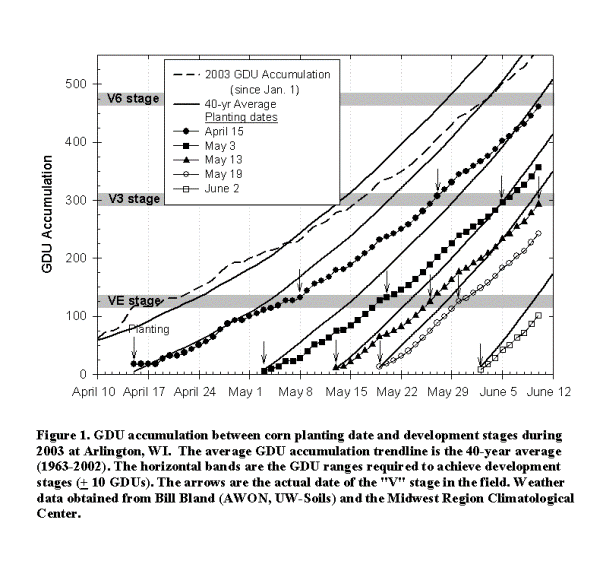
Tracking Corn Growth and Development: V6 Nearly Achieved for First Planting Date
June 12, 2003 10(13):99-100
Joe Lauer, Corn Agronomist
Growing degree unit accumulation continues to be slow for the 2003 growing season.
The corn crop achieves developmental stages when GDU accumulation benchmarks derived
from the model are achieved. The first planting date is nearly at V6. V6 is an important
event in the life cycle of a corn plant because all of the "machinery"
the plant will have for the season has been produced at the growing point. If you
dissect the plant, the tassel and all leaf traces are present on the growing point.
These structures only need to emerge and grow in size. The growing point is moving
above ground and is sensitive to frost (remember the Father's Day frost of 1992).
At V6, the plant is established and one yield component, ear density, is largely
determined for the season.
Yield in corn can be derived from three components: ear density, kernel number and
kernel mass. Ear density is at its greatest potential at planting. The population
seeded is the potential number of ears that will eventually be present at harvest,
since corn usually only produces one ear per plant. The initial population of corn
seeded is important and the optimum varies with management and field environment.
Usually about 90-95% of the seed planted eventually emerges and survives establishment.
Further attrition can occur with field operations like cultivation, pests that bore
into the stalk and kill the growing point, and environment events such as hail that
could kill or damage the plant.
Between V5 and V10 the potential of a second corn yield component is being determined.
Kernel number is a function of: 1) kernel rows around the ear, and 2) kernel number
along the row. The size or number of kernel rows varies from 8 to 22 and typically
averages about 12 to 16. The number of kernel rows on the ear will be determined
for the April 15 planting date over the next 10 to 14 days after V6. The potential
kernel number along the row will begin differentiation beginning around V8 and continue
until R1.
The April 15 planting date has achieved V5 and nearing V6. The May 3 planting date
achieved V3 on June 5 is currently at V4. The purpling observed last week on the
April 15 and May 3 planting date plots has disappeared, with only the leaf edges
still showing some purple. The May 13 planting date achieved V3 on June 11, while
the May 19 planting dates is at about V2.7. The June 2 planting date is currently
emerging with about 25% of the plants spiked. As soon as field conditions allow,
we will plant the last planting date of the 2003 season.
